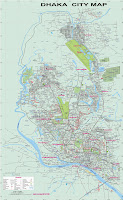

(L) Bangladesh- Population Density; (R) Bangladesh Administrative Map


(L) Bangladesh- Transport Network Map; (R) Bangladesh Rivers


(L) Bangladesh- Flood Affected Area; (R) Cyclone affected Zone


(L) Map- Climatic Zone; (R) Map Forest zone
(map ref: http://www.bangladesh.gov.bd/)


Dhaka City map - pre Mughal period

Bengal: from '1776 Rennell / Dury Map of Bihar & Bengal (save and zoom to read)
- one of the first accurate maps of the interior, laid out from primary
surveys done by James Rennell, the first modern cartographer to map
the interior of India.


adopted from Rennell's Map of Dhaka
 Rivers East Bengal- Rennell's Map of 1776 AD
Rivers East Bengal- Rennell's Map of 1776 AD
adopted from James Rennell's Map of Bengal showing Inland Navigation (1776)

Rennel's Dhaka City map of late 18th century

Dhaka City map in 1859- under British Occupation

Dhaka City Map- Capital of East Bengal and Assam during 1905-11

Dhaka City Map of 1914

Dhaka City map - fag end of British rule
(map ref: Wikipedia)

Dhaka rivers and canals (daily star)

76,000 buildings in Dhaka are in high risk to a magnitude 7 earthquake,



Dhaka city Image / Googles Earth Station Map of Dhaka
http://www.nationsonline.org/oneworld/map/google_map_Dhaka.htm


L: Dhaka Map of RAJUK website---R: Dhaka City Divide (N & S)
DAP (Detailed Area Plan) area is 1528 sq. km or 590 sq. miles which covers the total RAJUK's jurisdiction area, plus
- Gazipur Municipality to the North
- Dhaleshawri River to the south
- Bangshi and Dhaleshawri River to the west
- Shitalakkhya and Meghna River to the East
Mapping of Bengal:
James Rennell (1742-1830) was conceived in Devonshire, England turned into a geographer and marine specialist and made an investigation of the Bengal waterway bowls and mapped them despite anything that might have happened before. To expedite business route, Henry Vansittart, legislative leader of the Fort William, Calcutta gave him a requisition in Bengal Engineers of the Company's guard and endowed him with the particular avocation of making a study of the major waterways of Bengal and their tributaries. After the organization's procurement of the Diwani of Bengal, Bihar and Orissa (1765), the need for such a study was all the more distinctly felt. Senator Robert Clive consequently built a customary review branch in 1767 with James Rennell as its Surveyor General.
When, obviously, Rennell had all in all finished his investigations of the Ganges, Brahmaputra and Meghna stream frameworks. Dhaka was his operational central station. Initially, Rennell was utilized for just reviewing the Ganges delta with the uncommon target of discovering a shorter section suitable for substantial vessels from the Ganges to Calcutta, than that through the Sundarbans and the Meghna. His every day diary gives a point by point record of this voyage and of three consequent undertakings, throughout which he reviewed larger part of northern and eastern Bengal, infiltrating past Goalpara in Assam. Deficiently provided, he was struck by tigers, reptiles, dacoits and unfriendly individuals ordinarily as he finished the overview inside a compass of three years with the assistance of just four associates. It was while he was locked in on this calling on the outskirts of Kuch Behar that he was assaulted and intensely wounded by a gathering of the insubordinate supporters of Fakir Majnu Shah.
His endeavors were so acceptably made that later the Survey of India discovered his distinguishing pieces of proof astoundingly correct. To all clients —scholarly, regulatory and navigational, Rennell's Atlas was the reliable guide until expert maps were made accessible in mid nineteenth century. Rennell's second extraordinary work was the first more or less amend guide of India. The guide was joined by a Memoir (1783) holding a full record of the arrangement on which it was executed. Rennell resigned from the administration in 1776 not long after being elevated to the rank of Major in the Bengal Engineers. His Bengal Atlas, distributed in 1779, was a work of the most astounding essentialness from business, military and authoritative perspectives. To all clients -scholastic, authoritative and navigational, Rennell's Atlas was the steadfast direct until expert maps were made accessible in mid nineteenth century (ref: Banglapedia).
It's a compassion that Government, Tourism (Parjatan corp) or Dhaka City Corporation has yet to think of intuitive advanced guide of Dhaka city with pictures, milestones and way arranges 'ward by ward'. The Dhaka city maps economically printed by private firms "The Mappe" or "Graphosman"is too succinct and don't show portions of way system and points of interest of more amazing Dhaka.

No comments:
Post a Comment